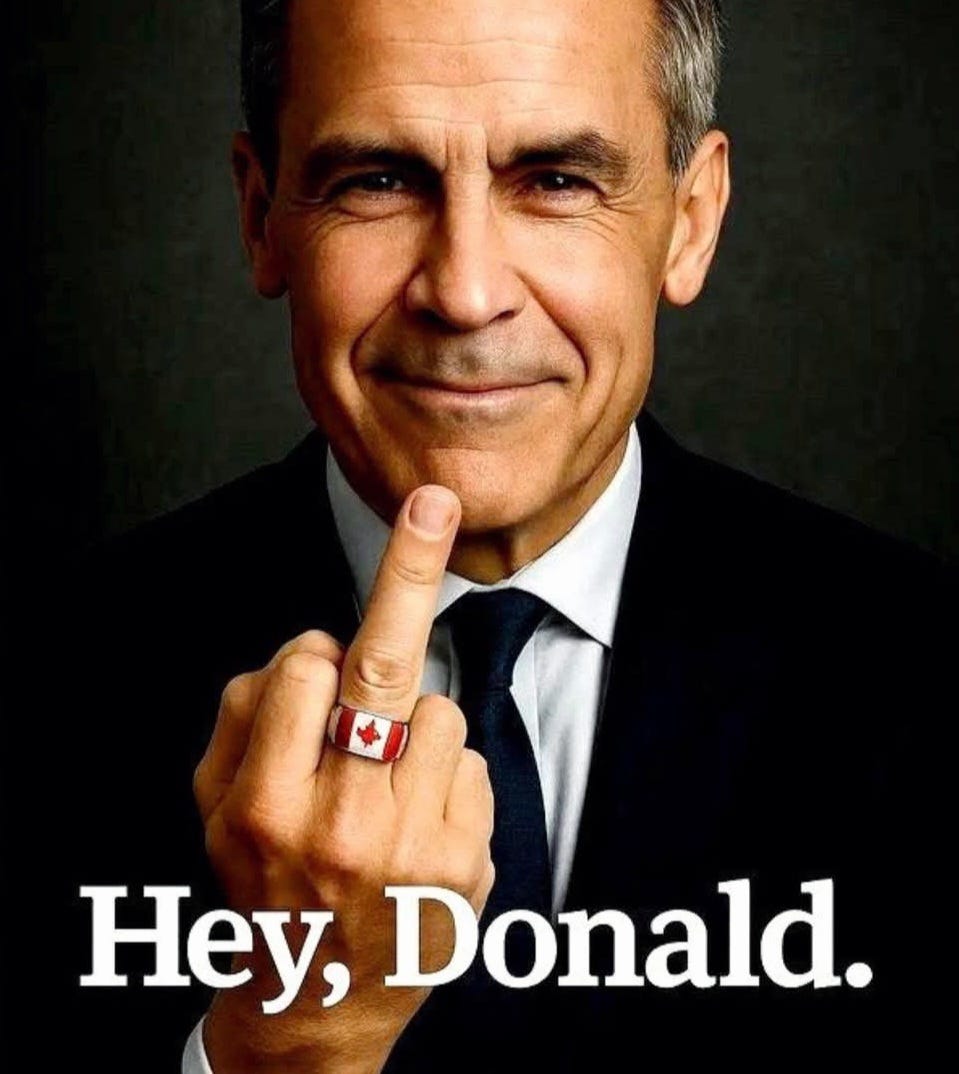How Canada Is Quietly Building Its Leverage Against the United States
Mark Carney didn’t just win an election. He inherited a neighbor having a midlife crisis in full view of the world — and decided, very quietly, to build an emergency exit.
While Trump was busy pitching Canada as the 51st state like a drunk realtor at a Fourth of July barbecue, Carney’s team started laying down the real groundwork: not for war, not for revenge, but for independence — the real kind, not the kind that blows $45 million on a Flag Day ego parade with tanks, flyovers, and a birthday salute to the world’s loudest draft dodger.
And now, with tariffs flying and tempers boiling, Carney is preparing to walk into the White House for one of the most contentious diplomatic meetings in decades — armed with leverage Trump handed him on a silver, duty-taxed platter.
CUTTING THE ECONOMIC UMBILICAL CORD
Until recently, Canada and the U.S. were bound by the United States-Mexico-Canada Agreement — a modernized trade deal Trump negotiated during his first term. That stability evaporated in March, when Trump fired the first shots in what is now a full-blown economic cage match.
He imposed sweeping 25% tariffs on Canadian steel and aluminum. The auto industry got caught in the blast radius — not through direct auto tariffs, but through rising supply chain costs and uncertainty. Canada fired back with C$30 billion in retaliatory tariffs, then another C$29.8 billion in response to the metal duties.
Total damage: nearly $44 billion in Canadian retaliatory measures alone — a full-body economic bruise.
But here’s the twist — the pain is hitting America harder.
General Motors CEO Mary Barra told CNN the tariffs would cost her company between $4 billion and $5 billion this year. Small businesses are bleeding too: one Minnesota baby gear company told CNN that a single shipment now costs nearly $230,000 to land on U.S. soil.
Carney’s response is surgical. He’s pushing new trade deals with Europe and Asia, creating a future where Canada doesn’t flinch when the U.S. throws a tantrum. If this keeps up, the U.S. won’t collapse — but it’ll lose a vital pressure release. Kind of like taking away the last working bathroom at a monster truck rally.
HOARDING THE GOOD STUFF
Critical minerals — cobalt, lithium, nickel, graphite — aren’t just shiny science fair prizes. They’re the backbone of every clean energy plan, smartphone, and defense system America has.
And guess what? Canada has piles of them.
Carney’s team is prioritizing sales to democratic allies and building domestic refining plants so raw materials stay in Canadian hands. It’s not official policy, but after being threatened with annexation on live television, let’s just say some buyers have been moved to the back of the line.
If the U.S. wants to go green, defend itself, or even make decent batteries — it’ll need Canada more than Canada needs America. That’s leverage so clean, it could be sold at Whole Foods.
BOLTING DOWN THE ARCTIC
Up at the top of the world, where the ice sheets are melting and the geopolitical knives are sharpening, Canada is done playing hall monitor.
Carney announced a C$30.9 billion investment in military upgrades focused on Arctic sovereignty — airfields, ports, patrols, the whole frosty arsenal. The plan is simple: the U.S. no longer gets automatic access to the Arctic party, Indigenous communities are being brought into leadership roles, and Canadian bases are getting built before anybody else — Russia, China, or the U.S. — thinks about squatting on the ice.
If the Arctic is the new frontier, Canada’s plan is simple: own the front door — and install a very polite but extremely firm bouncer.
BECOMING THE COOL KID IN DIPLOMACY CLASS
Carney’s not just fixing fences at home. He’s building a second house — one that doesn’t need America’s HOA permission slip.
He’s tightening alliances with Europe, pushing deeper into Asia and Latin America, and doubling down on multilateral forums where American tantrums don’t set the agenda.
If the U.S. wants to isolate itself into irrelevance, fine. Canada will be at the grown-ups’ table, passing the gravy.
SEALING OFF THE HOMELAND
Domestically, Canada is also patching the cracks. Housing policy is being used to shield from speculative bubbles, immigration is being recalibrated to stabilize public services, and energy independence is being pursued so American chaos doesn’t turn the lights off in Calgary.
Every move is a tiny, quiet step toward something radical: a Canada that doesn’t have to explain itself, apologize for itself, or ask permission anymore.
And today, Carney is heading to Washington. Not as a junior partner. Not as a friendly neighbor.
He’s walking into the West Wing as the calm, unshakable man who turned Trump’s economic bullying into a blueprint for sovereignty. He didn’t quote it word for word, but the message was clear: we’re over the shock of the betrayal — but we’re not stupid enough to forget it.
Trump thought he was strong-arming a neighbor. Instead, he handed them a passport out of empire.
One deal. One pipeline. One icebreaker at a time.
Enjoyed this piece?
Want to see how deep the iceberg goes? Join us at Closer to the Edge. We tell the stories corporate media won’t — with better jokes.
This post has been syndicated from Closer to the Edge, where it was published under this address.

